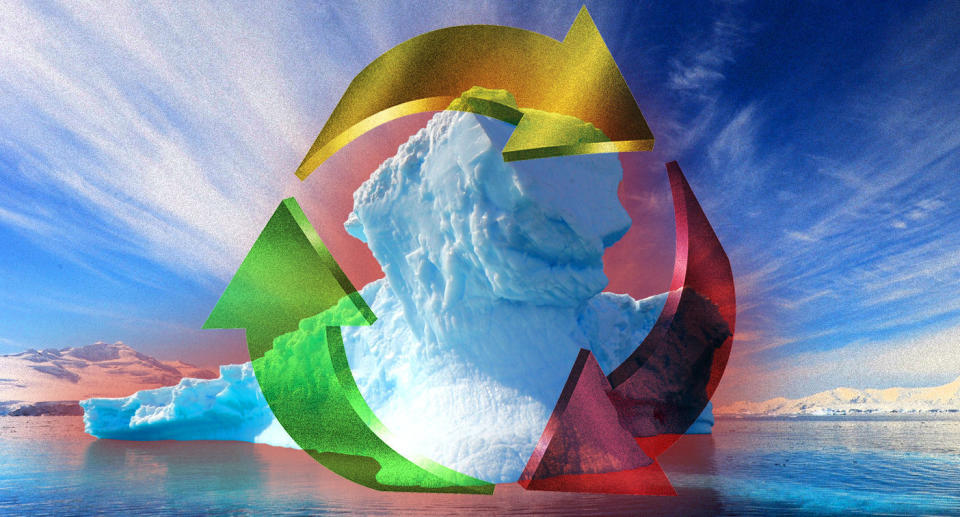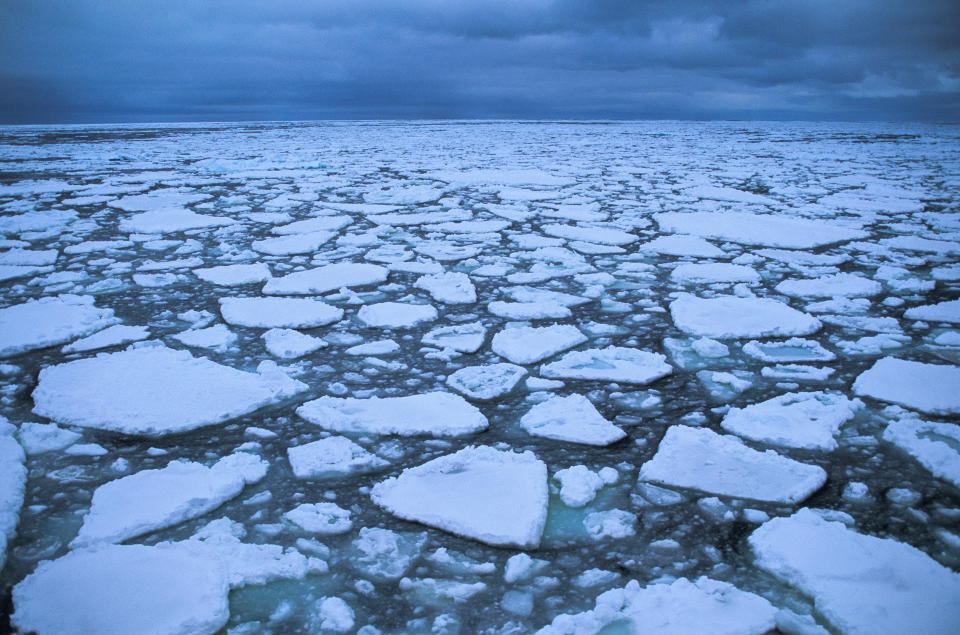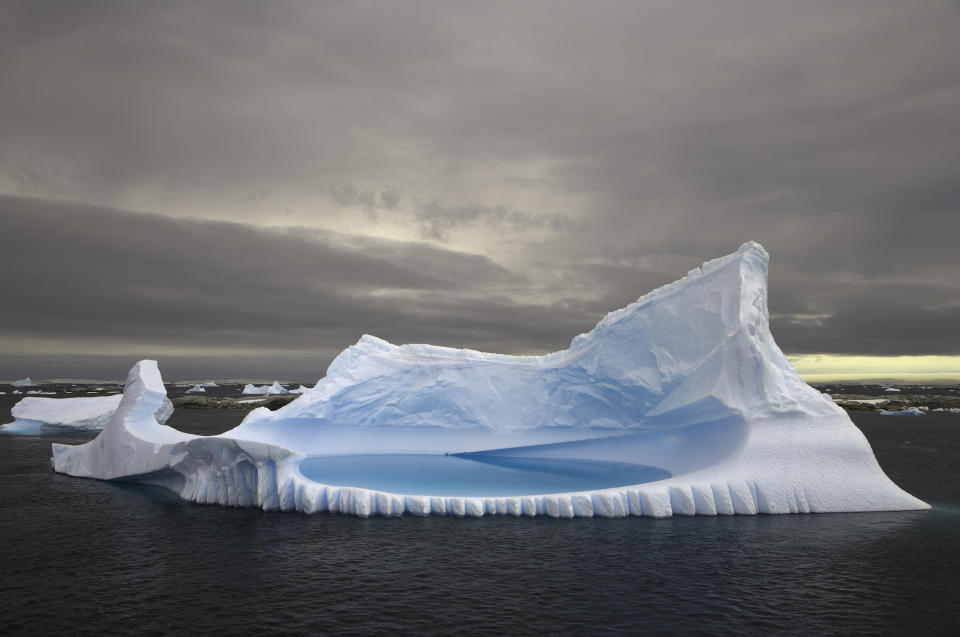'It's already begun': Feedback loops will make climate change even worse, scientists say
When the United Nations Intergovernmental Panel on Climate Change (IPCC) released its dire report in October warning of humanity’s fast-approaching reckoning with global warming, one factor adding to the urgency was a new estimate about how much additional carbon dioxide was being added to the atmosphere as a result of the warming of Arctic permafrost.
With rising Arctic temperatures setting free a vast amount of carbon previously locked beneath permafrost, the additional greenhouse gases released into the atmosphere would speed up warming, the report concluded — and that, in turn, would further melt the permafrost.

It is “feedback loops” like that one that make climate change unpredictable and represent a threat of global warming spiraling out of control.
“It’s already begun,” Thomas Crowther, professor in the Department of Environmental Systems Science of ETH Zurich, told Yahoo News. “The feedback is in process.”
Crowther estimates that carbon dioxide and methane emissions from thawing soils are “accelerating climate change about 12 to 15 percent at the moment,” and said past IPCC reports that left out the feedback “were way more optimistic than they should have been.”
Related Video: Investigating Glaciers’ Melting Problem
Almost every scientist studying the effects of climate change is worried about the extent to which feedback loops will hasten global warming. One of the most serious concerns is the “albedo effect,” the amount of the sun’s radiation the planet reflects back into space, mostly from the polar ice sheets. The warming that has already occurred has begun melting the ice caps, leaving the relatively dark ocean and land exposed to absorb solar radiation — further warming the planet and leading to more ice melt.
“The impact that it has on making the earth darker by removing all the snow and ice is estimated by some to be 25 to 40 percent of the warming that we’ve experienced,” Jennifer Francis, senior scientist at the Woods Hole Research Center, told Yahoo News. “In other words, global warming is that much worse. There’s a lot of ways these things are totaled all together.”
Feedback loops are not a root cause of the climate change problem, but they make the problem that much worse. When climatologists began seriously studying global warming in the 1970s, there was some doubt about how the feedback loops would operate. Scientists theorized there might also be negative feedback loops, which would slow global warming — for instance, by increasing cloud cover. But so far it has all gone in the opposite — wrong — direction.

“I’m not optimistic. It’s not just because of those feedbacks, it’s because we’ve already put so much carbon dioxide into the atmosphere and that carbon dioxide lasts a very long time,” Francis said. “A molecule of carbon dioxide, on average, lasts about 100 years in the atmosphere. So, we haven’t yet felt the impacts of the carbon dioxide that we’ve already put in the atmosphere. Even not thinking about feedbacks, we’re already got a lot more climate change built into the system just because it takes awhile for the climate system to adjust itself to this new level of greenhouse gases in the atmosphere. All the feedback that [happens is] just making that response even bigger than it would be otherwise.”
Francis has been researching how rising Arctic temperatures have been weakening the jet stream, causing shifts in weather and ocean current patterns that, in yet another feedback loop, warm the earth and further destabilize the jet stream.
“What we’re seeing is that the Arctic is warming much faster than the planet is farther south, making that north-south temperature difference much smaller and so there’s less of that fuel driving the jet stream wind,” Francis said. “That should cause the jet stream to take more of these big north-south swings. And the reason that’s important is because those waves in the jet stream are actually what create high- and low-pressure systems that we see on a weather map on TV and when you get those really big waves in the jet stream, they tend to move much more slowly, so those highs and lows we see on a weather map also tend to move much more slowly and so the weather conditions we see on the surface associated with those weather systems are much more persistent.”
Persistent weather patterns, such as periods of rain or drought lasting months, can have potentially devastating consequences, Francis said.
Harold Wanless, director of the University of Miami’s geological sciences department and a leading expert on sea level rise, has studied the rate at which the oceans have risen and retreated over millennia. He fears that a variety of feedback loops will contribute to a dramatic increase in sea level in the coming decades.
“My work on ancient climate shows we have these rapid pulses of rise that are rather dramatic, up to 10 meters of sea level rise certainly within a century, and that’s a really rapid disintegration of ice,” Wanless said. “We’re just seeing the beginning of ice melt and the beginning of the warming of the waters reaching up to the Arctic, in what is most certainly going to be the beginning of one of these rapid pulses.”

To Wanless, the evidence is clear that we’ve already reached a tipping point when it comes to the cascading impacts of climate change on sea level rise.
“Once you start adding up these different feedbacks, because that’s the only thing we have to go on in the modern era, well, there are all these things that are speeding up ice melt, some of which we’re just becoming aware of, like the collapse of the high ice sheets. We’re just trying to figure out how fast and how dramatic that will be,” Wanless says. “A lot of them work together. The warm water getting in under the outlet fjords of Greenland and Antarctica that ends up detaching the ice from the substrate and once that happens, you can have this sort of automatic fracturing of the detached ice like a stack of books starting to splay out off a table.”
It’s sobering to realize the extent to which the planet’s ecosystem is interconnected. For years, relatively little was known about the vital role the Arctic played in keeping the world stable. As the permafrost has begun to thaw, however, the global ramifications have become unavoidable.
“The permafrost acts like a giant freezer. The reason we have freezers in our kitchen is you put organic carbon in the form of food in your freezer and it doesn’t decompose,” said Charles Koven, research scientist at Lawrence Berkeley National Laboratory. “The same thing happens in these Arctic ecosystems. Plants grow and then die and form organic layers, kind of like compost on the surface of the soil and then over time, that carbon gets mixed down deeper into the soil where it gets locked into these deeper layers where it gets frozen and can stay for thousands of years.”
Koven is the author of a 2015 study that found that every 1 degree Celsius of warming releases from the permafrost the equivalent of 1.5 to two years of human-generated global carbon dioxide emissions.
“When you have warming, it causes the layer of soil that thaws every summer to thaw a bit deeper. It’s like taking stuff that’s been in your freezer and putting it into your fridge. It doesn’t last as long and it decomposes, and then you end up releasing greenhouse gases, carbon dioxide and methane.”
Yet Koven stressed that emissions from thawing permafrost were not, in and of themselves, necessarily catastrophic.
“The carbon that’s released from the permafrost isn’t such a strong feedback loop,” Koven said. “It’s more just that because you get this additional amount of carbon in the atmosphere with every additional bit of warming, that makes it that much more difficult to meet the kinds of climate targets that we’d like to.”

Roisin Commane, assistant professor of Earth and Environmental Sciences at Columbia University, has also been studying the thawing permafrost and was the lead author on the first study to show that Alaskan tundra was now a net emitter of carbon dioxide.
“Christmas Day last year the North Pole wasn’t frozen. The sea ice isn’t freezing, the soils aren’t freezing,” Commane told Yahoo News. “This past year, 2017-2018, a lot of Alaska’s North Slope and into Siberia never froze through. They had a very early snow, which provided an insulating layer and those soils never froze and the amount of CO2 and methane coming out was quite high.”
Unlike Wanless, who has witnessed firsthand the deterioration of the ice sheet in Greenland over decades, Commane has only recently begun traveling to the Arctic. Still, she has struggled with what she’s found there and fears that feedback loops will only exacerbate the metamorphosis of that landscape.
“All of our preconceived notions of what should be happening, they’re gone,” she said. “I didn’t grow up in the Arctic, so everything I’ve been learning about it is from what I’ve been reading. But then I go there and it’s a completely different place.”
_____
Read more from Yahoo News:
‘It’s over’: Miami Beach tries to save itself from climate change’s rising seas
Trump sought to obstruct Mueller — but White House aides wouldn't do it, report finds
Revealed: The U.S. military's 36 code-named operations in Africa
Video shows extensive fire damage inside Notre Dame Cathedral
Buttigieg’s ascent shows millennial revolution spreading to U.S.


